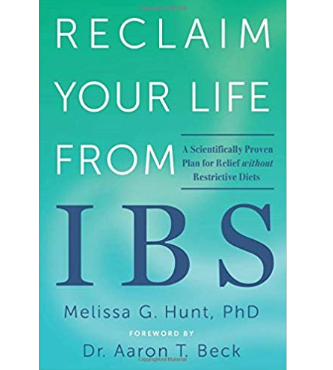Overcoming Irritable Bowel Syndrome (IBS)
Overcoming Irritable Bowel Syndrome (IBS)

Irritable Bowel Syndrome (IBS), an unpleasant and often debilitating condition, is characterized by frequent, recurrent abdominal pain, as well as problems with constipation and/or diarrhea. People with IBS often experience a strong urge to use the bathroom, and may avoid going to places without easy access to one. This means that many everyday locations (malls, parks, places of worship, movie theaters, classrooms, offices) feel risky, and people might start to limit their activities as a result. People with IBS also start to fear and avoid many foods believed to trigger IBS attacks, often leading to loss of pleasure in eating as well as reduced opportunities to socialize. This fuels a vicious cycle of discomfort, anxiety, vigilance, avoidance and visceral hypersensitivity, in which GI sensations get horribly amplified. For people with IBS, indigestion can feel like a terrifying event which could lead to excruciating pain, incontinence and humiliation.
Luckily for sufferers of IBS, cognitive behavioral therapy (CBT) has been found to be an effective treatment for the condition. First, it is important for the practitioner to consult the patient’s other medical providers and ensure that several alternative diagnoses have been ruled out. The most important rule outs are inflammatory bowel diseases (Crohn’s and Colitis) and celiac disease (which leads to complete gluten intolerance). Fortunately, simple blood and stool tests are usually enough to rule these conditions out. The next step is educating the patient about the link between stress and arousal of the sympathetic nervous system, which can directly impact GI discomfort. IBS is not “all in your head” – the pain and GI dysfunction are very real. But stress makes GI problems worse through direct biological mechanisms. The practitioner should then train the patient in relaxation techniques like deep belly breathing.
Once the patient is able to use these relaxation techniques effectively, it is time to introduce the CBT model, which teaches that beliefs (not situations) affect our emotions and that beliefs can be inaccurate. Inaccurate beliefs, in this case catastrophic beliefs and predictions about GI symptoms, can be altered with the help of behavioral experiments. For example, it can be helpful to send the patient to a movie theater or house of worship and have them sit in the back and count the number of people who get up and leave and then return. Often, the patient will be surprised at how often this happens and how little other people react; it can help the patient understand that having to get up and use the bathroom is not a big deal.
The final step in CBT is exposure therapy in which the patient starts doing things they’ve been avoiding. For example, if they are afraid of long car trips, have them start by sitting in the car in their driveway for thirty minutes. Once that gets boring and easy, have them drive around the block 20 times. Then have them drive a mile away from home and back, and so on. If the patient fears incontinence, then in the safety of their own home have them experiment with “holding it” when they feel the urge, first for 30 seconds, then a minute, then 5 minutes. This will prove to them that they are able to “hold it” and catastrophizing is unnecessary.
This CBT treatment is presented at a much more detailed level in the book Reclaim Your Life from IBS: A Scientifically Proven Plan for Relief Without Restrictive Diets. The book was actually tested in a randomized controlled trial and was shown to be quite effective (Hunt, M., Ertel, E., Coello, J. & Rodriguez, L. (2014). Empirical Support for a Self-Help Treatment for IBS. Cognitive Therapy and Research, 39(2), 215-227).
You can also hear Dr. Hunt discuss this treatment strategy on an ADAA webinar, Overcoming Irritable Bowel Syndrome (IBS): Reclaim Your Life from Anxiety and Distress about IBS Symptoms.












